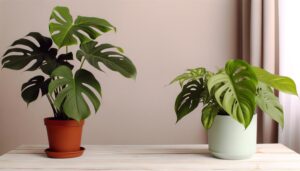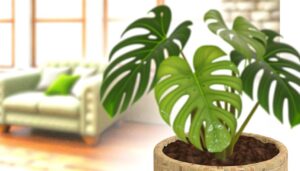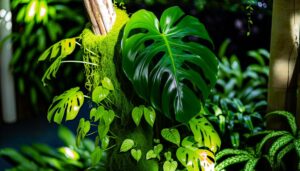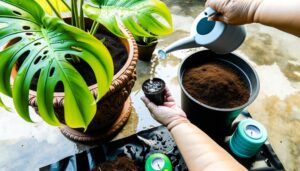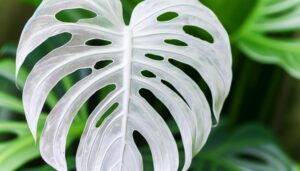Monstera Lechleriana Vs Laniata
When comparing Monstera Lechleriana and Monstera Laniata, focus on their leaf structures and growth patterns. Lechleriana has fewer but larger perforations and climbs using aerial roots, while Laniata features numerous smaller fenestrations and spreads via stems.
Lechleriana thrives with bright, indirect sunlight, whereas Laniata prefers medium to bright light. Both species benefit from high humidity, and the right soil mix includes peat moss, perlite, and orchid bark.
For optimum watering, wait until the top 2-3 inches of soil are dry. You'll also want to watch for pests like spider mites and aphids.
Stay tuned to grasp more intricate care guidelines.
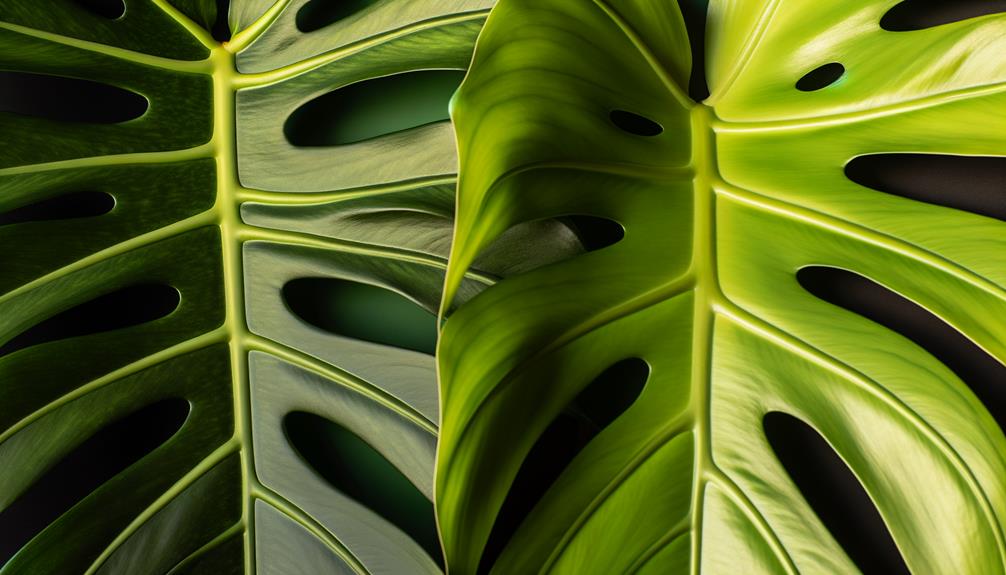
Key Takeaways
- Monstera Lechleriana has fewer, larger perforations, whereas Monstera Laniata features numerous smaller, intricate fenestrations.
- Lechleriana has oval-shaped leaves, while Laniata's leaves are more elongated with deep fenestrations.
- Lechleriana climbs vigorously with aerial roots; Laniata spreads out using stems.
- Lechleriana prefers bright, indirect sunlight, whereas Laniata thrives in medium to bright, indirect sunlight.
- Lechleriana's leaves have larger holes closer to the midrib; Laniata's smaller fenestrations are evenly spread.
Origin and Background

To understand Monstera Lechleriana and Laniata, you need to explore their origins in the tropical rainforests of Central and South America. Both species thrive in humid, shaded environments, often climbing trees with their aerial roots. They belong to the Araceae family and are epiphytic by nature. This means they grow on other plants for physical support without extracting nutrients from them.
These regions' consistent moisture and warm temperatures create an ideal habitat for these Monsteras, allowing them to develop their distinctive characteristics. Their adaptation to these environments includes efficient water usage and robust root systems. By studying their native ecosystems, you gain insight into their specific care requirements, helping ensure their health and growth in your home or garden.
Leaf Structure
When you examine the leaf structure of Monstera Lechleriana and Laniata, you'll notice distinct fenestration patterns that set them apart.
Monstera Lechleriana typically exhibits fewer but larger perforations, while Laniata features numerous smaller, more intricate fenestrations.
Additionally, the leaf texture of Laniata is generally smoother compared to the slightly rougher surface of Lechleriana leaves.
Fenestration Patterns
While both Monstera Lechleriana and Laniata exhibit fenestrations, the patterns and structures of their leaf perforations differ substantially, reflecting their unique adaptations and evolutionary paths.
You'll find that Monstera Lechleriana typically has fewer, larger holes closer to the midrib, allowing for efficient light penetration and airflow.
In contrast, Monstera Laniata displays more numerous, smaller fenestrations spread evenly across the leaf, optimizing photosynthetic efficiency in lower light environments.
Here are the key differences in their fenestration patterns:
- Size of Fenestrations: Larger in Lechleriana, smaller in Laniata.
- Quantity: Fewer in Lechleriana, more in Laniata.
- Distribution: Centralized in Lechleriana, even in Laniata.
- Functional Adaptation: Light and airflow in Lechleriana, photosynthesis in Laniata.
Leaf Texture Differences
Unlike their fenestration patterns, the leaf textures of Monstera Lechleriana and Laniata reveal distinct structural differences. Monstera Lechleriana exhibits a thicker, more robust surface, with leaves that are coriaceous, giving them a leather-like feel. This texture aids in water retention and durability.
On the other hand, Monstera Laniata showcases a thinner, more delicate texture. Its leaves are more membranous, providing a softer, almost papery touch. This thin texture allows for more efficient gas exchange but requires higher humidity to prevent desiccation.
Understanding these texture differences is crucial for catering to each plant's specific environmental needs. By doing so, you can ensure optimal growth and health for both Monstera Lechleriana and Monstera Laniata.
Growth Patterns
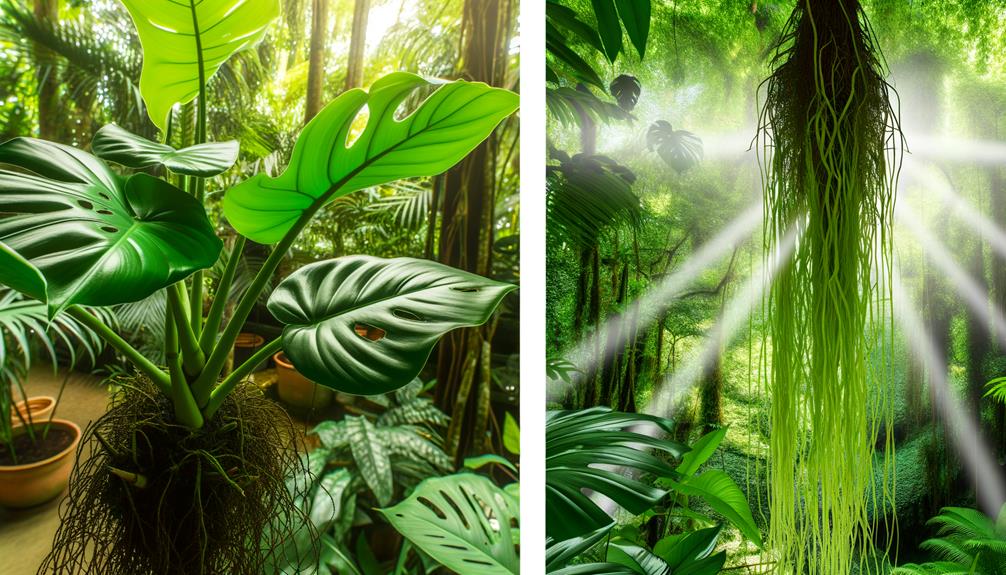
When comparing Monstera Lechleriana and Laniata, you'll notice distinct differences in their growth patterns.
Lechleriana exhibits a more climbing habit, while Laniata tends to spread out.
Both species have varying light requirements that directly influence their development and vigor.
Leaf Shape Differences
Monstera lechleriana exhibits more oval-shaped leaves with fewer perforations, whereas Monstera laniata displays elongated, deeply fenestrated leaves. Understanding these leaf shape differences is crucial in identifying each species.
Here are the main points to take into account:
- Shape: Monstera lechleriana's leaves are more oval and less segmented, while Monstera laniata's leaves are elongated with extensive fenestrations.
- Fenestrations: Lechleriana has fewer, smaller holes, making its leaves appear more solid compared to the laniata's pronounced perforations.
- Leaf Texture: Lechleriana leaves are generally smoother and thicker, whereas laniata leaves can be thinner and more delicate.
- Size: Both species can grow large, but laniata leaves often appear more prominent due to their dramatic fenestrations.
Understanding these differences helps you clearly differentiate between the two species.
Climbing Vs. Spreading
While leaf shape is a key identifier, understanding the growth patterns of Monstera lechleriana and Monstera laniata provides further clarity. Lechleriana tends to climb vertically with strong aerial roots, attaching itself to supports like tree trunks or moss poles with its adventitious roots, facilitating vertical ascent. In contrast, laniata often exhibits a more spreading habit, utilizing its long stems to cover wider areas.
You'll notice lechleriana attaching itself to supports, like tree trunks or moss poles, with its adventitious roots, which facilitate vertical ascent.
In contrast, laniata's growth pattern is characterized by extensive lateral spreading, using its elongated stems to establish a broader presence.
This difference in growth patterns indicates their adaptability to various environments, with lechleriana thriving in vertical spaces and laniata efficiently occupying horizontal areas. Understanding these patterns aids in ideal plant placement and care.
Light Requirements Comparison
Fascinatingly, how do the light needs differ between Monstera lechleriana and Monstera laniata, given their distinct growth patterns? You'll find that their needs vary, impacting their overall development and health.
- Monstera lechleriana: Prefers bright, indirect sunlight. It can tolerate low light but may grow slower and develop smaller leaves.
- Monstera laniata: Thrives in medium to bright, indirect sunlight. It's less tolerant of low light and may exhibit leggy growth if light is insufficient.
- Growth Patterns: Lechleriana tends to climb more vigorously under ideal light, while Laniata spreads and climbs but needs more light to prevent etiolation.
- Light Intensity: Both species benefit from filtered sunlight, resembling their natural understory habitat.
Understanding these requirements helps promote robust growth and vibrant foliage.
Light Requirements
Both Monstera Lechleriana and Laniata thrive in bright, indirect sunlight, which mimics their natural tropical habitat. Place them near east or west-facing windows for ideal light absorption. Direct sunlight can cause leaf scorch, while insufficient light hampers their growth and variegation.
Monitor your plants for signs of light deficiency, such as leggy growth or small, pale leaves. Using a light meter can help you ensure they receive 1000-2000 lumens.
If natural light is limited, supplement with fluorescent or LED grow lights set to a 12-14 hour cycle. Remember, consistent light levels are essential for maintaining their health and promoting robust foliage.
Watering Needs
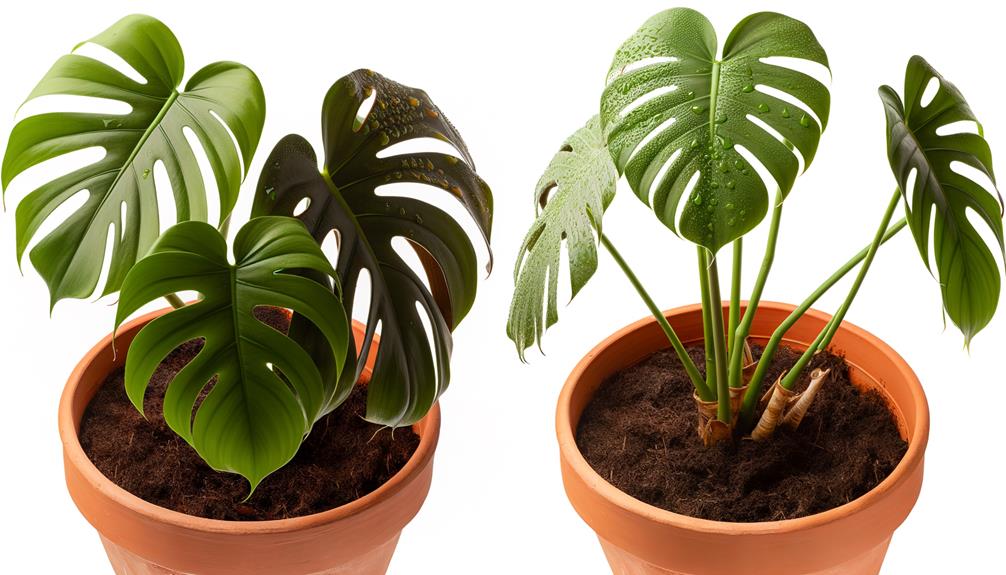
Verifying proper watering is crucial for Monstera Lechleriana and Laniata, as both are sensitive to overwatering and root rot. You should water these plants when the top 2-3 inches of soil feel dry. Overwatering can lead to fungal infections and poor oxygenation of roots.
Here's a detailed guide to help you:
- Check Soil Moisture: Use your finger or a moisture meter to confirm the soil is dry before watering.
- Water Quality: Use filtered or rainwater to avoid chlorine and fluoride, which can harm roots.
- Drainage: Make sure pots have drainage holes to prevent water accumulation.
- Humidity: Maintain high humidity levels, as it reduces the frequency of watering needed.
Soil Preferences
For Monstera Lechleriana and Laniata, using a well-draining soil mix rich in organic matter is essential for promoting healthy root growth and preventing waterlogging. Choose a blend containing peat moss, perlite, and orchid bark. Peat moss retains moisture without becoming soggy, perlite enhances aeration, and orchid bark guarantees drainage. These components mimic the plants' natural epiphytic environment, promoting ideal air circulation around the roots.
Avoid heavy soils that compact easily, as they can lead to root rot. Regularly check the soil's moisture level; maintain a balance between moist and dry to prevent stress. By understanding and applying these principles, you'll cultivate thriving Monstera Lechleriana and Laniata plants, optimizing their longevity and vigor.
Humidity Levels
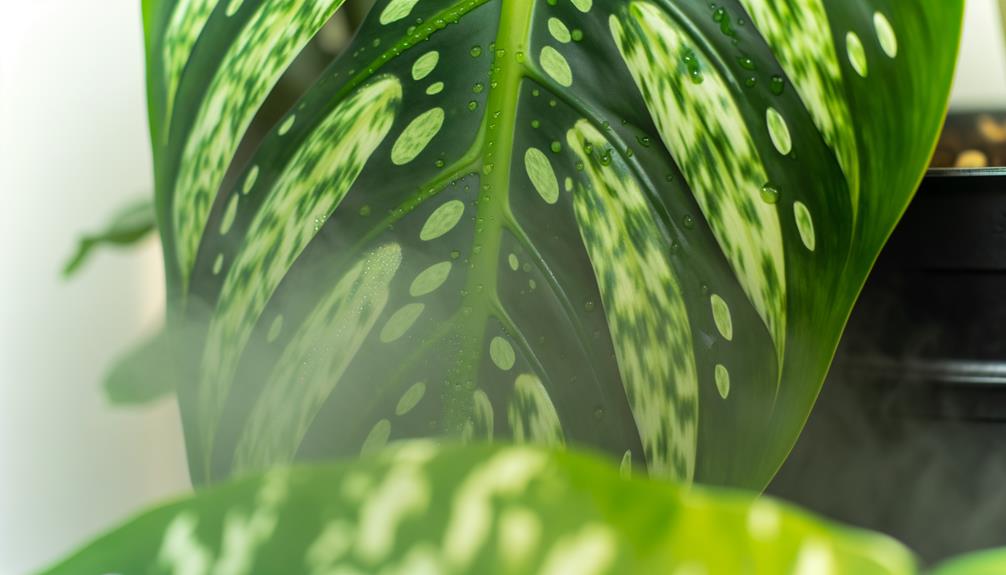
After establishing the right soil mix, maintaining high humidity levels is essential for the best growth of Monstera Lechleriana and Laniata. Both species thrive in environments with humidity levels between 60-80%. Consistent humidity not only promotes vigorous growth but also helps prevent leaf browning and curling.
To achieve ideal humidity, consider the following:
- Use a Humidifier: Place a humidifier near your plants to maintain stable humidity levels.
- Mist Regularly: Lightly mist the leaves daily to replicate their natural tropical habitat.
- Pebble Trays: Set your pots on trays filled with water and pebbles to increase ambient moisture.
- Group Plants Together: Clustering plants creates a microenvironment with higher humidity.
Common Pests
Battling pests like spider mites, aphids, and mealybugs is a fundamental aspect of maintaining the health of your Monstera Lechleriana and Laniata. Spider mites thrive in dry conditions, causing stippling on leaves. Combat them with regular misting and insecticidal soap.
Aphids, identified by their pear-shaped bodies, cluster on new growth. Use neem oil or a strong water spray to dislodge them.
Mealybugs appear as white, cotton-like masses on stems and leaves, sucking sap and causing stunted growth. Apply rubbing alcohol on a cotton swab to remove them physically.
Regularly inspect your plants, as early detection is vital. Integrated Pest Management (IPM) strategies, emphasizing prevention and natural predators, will guarantee your Monstera thrives pest-free.
Propagation Tips
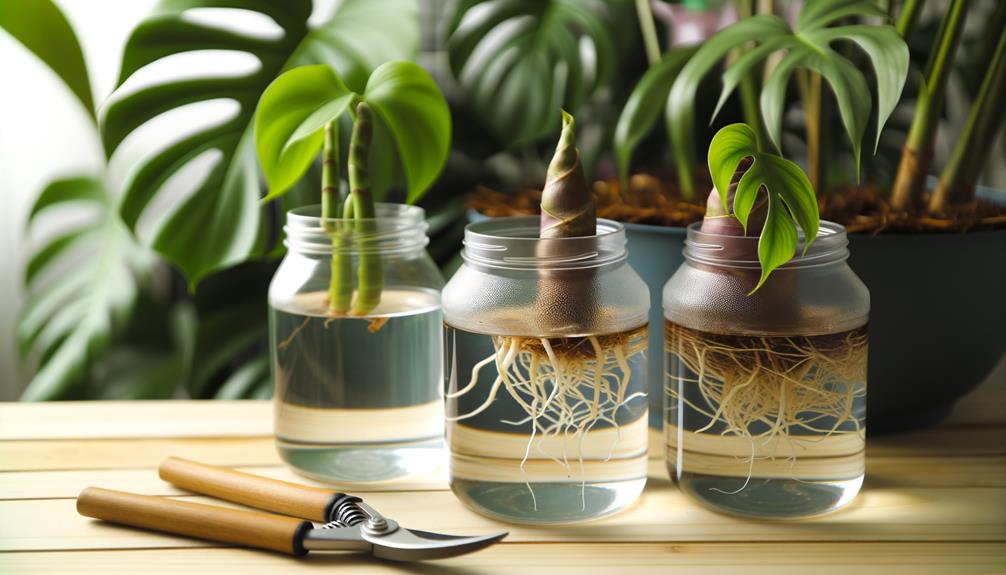
Maintaining healthy Monstera Lechleriana and Laniata plants also involves understanding effective propagation methods to expand your collection. Here are precise tips to help you propagate these stunning plants:
- Stem Cuttings: Select a healthy stem with at least one node and aerial root. Cut just below the node and plant in well-draining soil.
- Water Propagation: Place the cutting in a jar of water, making certain the node is submerged. Change water weekly until roots form.
- Soil Propagation: Insert the cutting directly into moist, well-aerated soil. Maintain humidity with a plastic cover.
- Air Layering: Wrap a node on the parent plant with moist sphagnum moss and plastic. Once roots develop, cut and plant separately.
These methods guarantee robust growth and successful propagation.
Conclusion
In your quest to cultivate the perfect Monstera, understanding the nuances between Lechleriana and Laniata is like deciphering a botanical code.
Each has its unique leaf structure, growth patterns, and specific needs for light, water, soil, and humidity.
By mastering these details, you're not just growing plants; you're nurturing living art.
So, embrace the challenge, and let your indoor garden flourish with the precision of a well-conducted scientific experiment.


